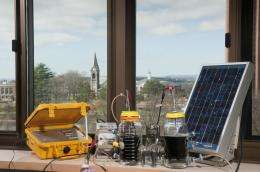Researchers Developing Potentially 'Transformative' Method to Produce Clean, Green Biofuels (w/ Video)

(PhysOrg.com) -- A new way to make valuable chemicals and more affordable “green” fuel from solar power, bacteria and carbon dioxide could be "truly transformative" for our society if it works on a commercial scale, says microbiologist Derek Lovley, head of a research group developing the method at the University of Massachusetts Amherst.
“This could be the most exciting and significant development in alternative fuels in years,” Lovley says. His microbial electrosynthesis (ME) process is carbon neutral and uses solar energy more efficiently than plants. In fact, it provides a solution to one of the major problems of using solar panels to produce electricity: Storage. This technique immediately turns solar power directly into chemicals, which are then readily stored with existing infrastructure and distributed on demand.
Further, ME requires no biomass feedstock or arable land, uses far less water and requires no elaborate post-production fermentation, for example. And, once established, the microbial cells and electrode food sources don’t get used up, so they are more than 90 percent efficient at turning electrons into fuel without further processing. Lovley and colleagues published their experimental results and discuss implications in the current, May issue of mBIO, an online journal of the American Society of Microbiology.
Findings are being presented this week at the American Society for Microbiology’s annual meeting in San Diego, which runs from May 23-27.
“One reason this process is so exciting is that we go directly from carbon dioxide to fuel, bypassing all kinds of difficulties encountered in producing fuels from biomass. We’re very excited about the high efficiencies and the promise of extremely high payback for the investment in this new alternative energy process,” says Lovley.
At present, their bench-top process produces small quantities of fuel, but a recent $1 million initial grant from the U.S. Department of Energy means work at UMass Amherst will proceed on developing larger scale production. The grant and recent recognition of his lab as one of the nation’s most promising alternative energy incubators were gratifying, but Lovley says he’s even more thrilled to be developing a technology that could decisively free us from dependence on greenhouse gas-emitting foreign oil.
This new technology is based on the discovery in the UMass Amherst lab that some bacteria can feed on electrons delivered by electrodes. These microbes live on the electrodes and use electrons released from them as their food source. “This is basically a new form of photosynthesis, in which carbon dioxide and water are combined to produce organic compounds, and oxygen is released as a byproduct,” Lovley explains.
Electric energy powers the microbes to “breathe in” carbon dioxide and “exhale” fuels and chemicals. Any source of electricity will do, but the technology is primarily designed to be used with solar panels as a source of clean, renewable solar energy. A notable advantage to this new method is that the photovoltaics, or solar panels, can harvest solar energy 100 times more effectively than plants.
Right now the main product is acetate or acetyl-Co A, a basic building block or “central intermediate” from which all sorts of fuels and other chemicals can be easily produced, notably butanol, which is a direct replacement for gasoline and deliverable through existing pipelines. “Acetyl-Co A is central to all biology and bacteria can be directed to make almost anything from this,” Lovley says.
In practical terms, the closed ME system Lovley envisions could be located anywhere sunlight is available, and harvested with an array of solar panels. As he explains, “It’s a two-electrode system. One electrode extracts electrons from water and produces oxygen as a byproduct. The electrons travel to the second electrode where the bacteria are, and they take in carbon dioxide and spit out acetate. With further engineering the bacteria are expected to also be able to produce fuels or other valuable commercial chemicals, for example, butanediol, used to make plastics. ”
If positioned next to a smokestack, the process could reduce the carbon footprint of existing CO2 emitters such as power plants, Lovley confirms.
Provided by University of Massachusetts Amherst















